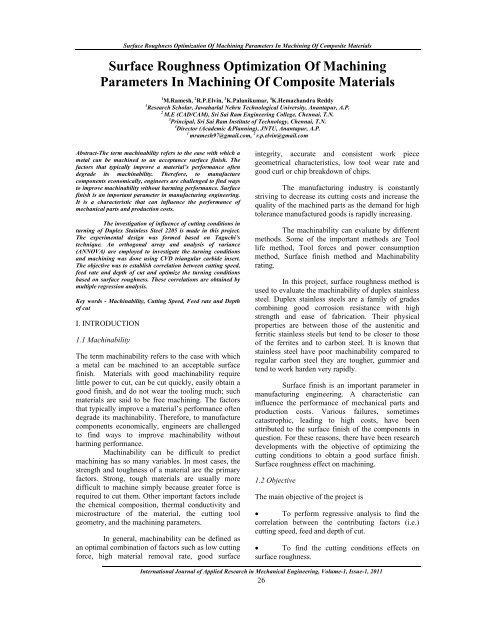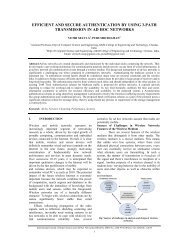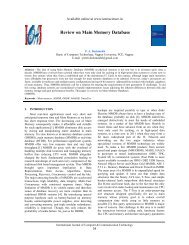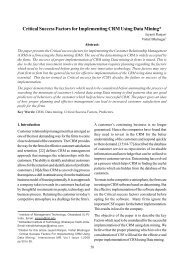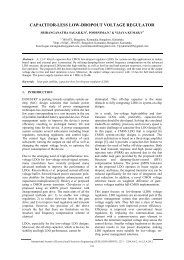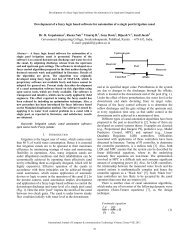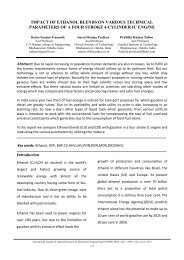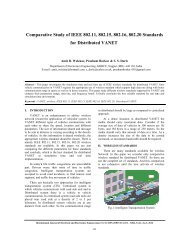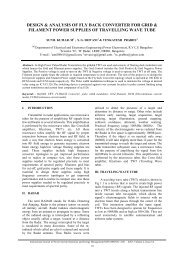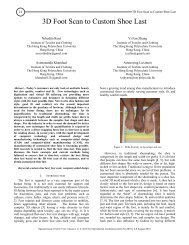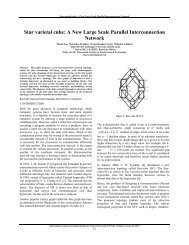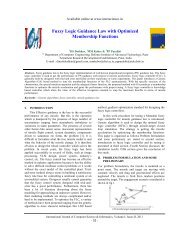Surface Roughness Optimization Of Machining Parameters In ...
Surface Roughness Optimization Of Machining Parameters In ...
Surface Roughness Optimization Of Machining Parameters In ...
Create successful ePaper yourself
Turn your PDF publications into a flip-book with our unique Google optimized e-Paper software.
<strong>Surface</strong> <strong>Roughness</strong> <strong>Optimization</strong> <strong>Of</strong> <strong>Machining</strong> <strong>Parameters</strong> <strong>In</strong> <strong>Machining</strong> <strong>Of</strong> Composite MaterialsThe chemical composition of duplexstainless steel 2205(UNS number S31803) is given inthe table below.Cutting(m/min)speedFeed (mm/rev)150 0.1 0.5150 0.1 1150 0.1 1.5150 0.15 0.5150 0.15 1150 0.15 1.5150 0.2 0.5150 0.2 1150 0.2 1.5200 0.1 0.5200 0.1 1200 0.1 1.5200 0.15 0.5200 0.15 1200 0.15 1.5200 0.2 0.5200 0.2 1200 0.2 1.5250 0.1 0.5250 0.1 1250 0.1 1.5250 0.15 0.5250 0.15 1250 0.15 1.5250 0.2 0.5250 0.2 1250 0.2 1.5Depth of cut(mm)2.3 Cemented carbidesCemented carbide, also called tungstencarbide cobalt or hard metal, hard material are usedin machining through materials such as carbon steelor stainless steel, as well as in situations where othertools would wear away, such as high quantityproduction runs. Most of the time, carbide will leavea better finish on the part, and allow fastermachining. Carbide tools can also withstand highertemperatures than standard high speed steel tools.Metal carbide tools, which are also oftencalled hard metal tools, are made by mixing togetherpowders of cobalt (chemical symbol Co) and metalcarbide (usually tungsten carbide, WC). These arethen sintered using powder processing techniques.The particle of carbide (which are hard and verystrong, even at machining temperatures) from thecutting surfaces of the tool and the function of thecobalt is simply to hold together all the carbidesparticles.The straight tungsten carbides are finelypowdered tungsten carbide (85-95%) and cobalt (5-15%) which acts as a bonding medium.III. SURFACE ROUGHNESS<strong>Roughness</strong> plays an important role indetermining how a real object will interact with itsenvironment. Rough surfaces usually wear morequickly and have higher friction coefficient thansmooth surfaces. <strong>Roughness</strong> is often a good predictorof the performance of a mechanical component, sinceirregularities in the surface may form nucleation sitesfor cracks or corrosion.3.1 Measurement<strong>Roughness</strong> may be measured using contactor non-contact method.Elements%CompositionCarbon0.03 maxManganese 2Silicon 1Phosphorous 0.03Sulphur 0.02Chromium 21-23Molybdenum 2.5-3.5Nickel 4.5-6.5Nitrogen 0.08-0.2CopperNil<strong>In</strong>ternational Journal of Applied Research in Mechanical Engineering, Volume-1, Issue-1, 201128
<strong>Surface</strong> <strong>Roughness</strong> <strong>Optimization</strong> <strong>Of</strong> <strong>Machining</strong> <strong>Parameters</strong> <strong>In</strong> <strong>Machining</strong> <strong>Of</strong> Composite MaterialsThe surface roughness for the machined work pieceis measured by contact method. The instrument usedis matutoyo SJ 201.3.2 Technical dataX-axis (drive unit)Measuring range: 12.5mmMeasuring speed: 0.25, 0.5mm/s (0.25mm/s: S-type)Traversing direction: backwardsDetector range: 350µm (-200µmto+150µm)Detecting method: skid measurementMeasuring force: 4mNStylus tip: diamond, 90°/5µmRSkid radius of curvature: 40mmSkid force: less than 400mNThe machining parameters chosen for theexperiments were 1. Cutting speed, 2. Feed, 3.depthof cut.3.4 Cutting conditionsFrom the machining handbook maximumcutting speed up to which cemented carbide tool canbe used is 300m/min. the feed rate was 0.1,0.15,0.2mm/rev. depth of cut used was 0.5,1,1.5mm.Chemical composition of 2205 duplex stainlesssteelElementsCarbonManganese 2Silicon 1%composition0.03maxPhosphorous 0.03Sulphur 0.02chromium 21-23Detecting method: differential inductancePower supply: rechargeable batteryDIMENSIONS (W×D×H)Control unit: 307×165×94mmDrive unit: 115×23×26mmMASSControl unit: approx.0.3kg (SJ-201)Drive unit: 0.2kg3.3 Design of experimentsTaguchi method is a powerful tool fordesign of experiments. He developed philosophy andmethodology for continuous quality improvement inproduct and process.Factors Level1 Level2 Level3Cuttingspeed(m/min)150 200 250Feed(mm/rev) 0.1 0.15 0.2Depth of cut(mm) 0.5 1 1.5Molybdenum 2.5-3.5Nickel 4.5-6.5nitrogen 0.08-0.2copper3.5 Experimental procedureNilThe work piece was first fixed in the chuckof the cnc machine. The length of work piece is110mm in which the 40mm was used for holding onthe chuck. The remaining length (i.e.) 60mm wasused for machining. The cutting tool was allowed toslightly touch the right side of the work piecematerial and the coordinates of the start of the workpiece were set on the cnc lathe. The cutting tool wasthen allowed to slightly touch the surface of the workpiece material, and the diameter of the work piecewas set in the cnc lathe. Then machining was carriedout in different cutting condition, totally there were27 cutting conditions (i.e.) with constant cuttingspeed and feed we varied the depth of cut. Similarlymachining was carried out in all the work pieces.After machining the surface roughness of the workpiece at different cutting conditions were measuredusing Mitutoyo SJ201.the chip produces during eachcutting condition was collected and chip analysis wascarried out.<strong>In</strong>ternational Journal of Applied Research in Mechanical Engineering, Volume-1, Issue-1, 201129
<strong>Surface</strong> <strong>Roughness</strong> <strong>Optimization</strong> <strong>Of</strong> <strong>Machining</strong> <strong>Parameters</strong> <strong>In</strong> <strong>Machining</strong> <strong>Of</strong> Composite Materials250 0.15 0.5 0.8IV. RESULTMinitab16 software was used for performingthe regression analysis to find the correlation betweenthe contributing factors and graph was plotted to findthe effect of contribution factor on surface roughness.4.1 Regression analysisIt is used to investigate and model therelationship between a response variable and one ormore predictors. Mintlab provides least square,partial least square and logistic regressionprocedures.Cuttingspeed(m/min)Feed(mm/rev)Depth ofcut (mm)Ra(µm)150 0.1 0.5 1.68150 0.1 1 1.6150 0.1 1.5 1.59150 0.15 0.5 1.87150 0.15 1 1.14150 0.15 1.5 2.62150 0.2 0.5 2.24150 0.2 1 2.39150 0.2 1.5 2.3200 0.1 0.5 0.6200 0.1 1 1.67200 0.1 1.5 2.78200 0.15 0.5 1.97250 0.15 1 1.35250 0.15 1.5 1.02250 0.2 0.5 1.64250 0.2 1 1.79250 0.2 1.5 2.094.2 Regression Analysis (RA) versus speed, feed, depth of cutRa=1.18-0.00567 speed + 7.78 feed +0.604 depth ofcutPredictor Coef SE Coef T PConstant 1.183 0.6473 1.83 0.00Speed -0.005 0.0023 -2.38 0.026Feed 7.78 2.377 3.27 0.000doc 0.6044 0.2377 2.54 0.018S=0.504186 R-Sq = 49.8% R-Sq (adj) =43.3%Press=7.76 R-Sq (pred) =33.43%Analysis of variancesource df ss ms f pRegression 3 5.81 1.94 7.62 0.001Residualerror23 5.85 0.25 - -Total 26 11.65 - - -200 0.15 1 1.72200 0.15 1.5 2.55200 0.2 0.5 2.02200 0.2 1 3.31200 0.2 1.5 2.78250 0.1 0.5 1.16250 0.1 1 0.79Sequential sum of squaresSource df Seq ssSpeed 1 1.445Feed 1 2.722doc 1 1.644250 0.1 1.5 1.69<strong>In</strong>ternational Journal of Applied Research in Mechanical Engineering, Volume-1, Issue-1, 201130
<strong>Surface</strong> <strong>Roughness</strong> <strong>Optimization</strong> <strong>Of</strong> <strong>Machining</strong> <strong>Parameters</strong> <strong>In</strong> <strong>Machining</strong> <strong>Of</strong> Composite MaterialsUnusual observationGraph:ObSpeedRa fit SEfitResidualStresid5 150 1.14 2.1012 200 2.78 1.7317 250 3.31 2.200.15 -0.96 -2.01R0.19 1.04 2.25R0.15 1.10 2.29RR denotes observation with a large standardizedresidual.Residual plots for surface roughness:<strong>In</strong>ternational Journal of Applied Research in Mechanical Engineering, Volume-1, Issue-1, 201131
<strong>Surface</strong> <strong>Roughness</strong> <strong>Optimization</strong> <strong>Of</strong> <strong>Machining</strong> <strong>Parameters</strong> <strong>In</strong> <strong>Machining</strong> <strong>Of</strong> Composite Materials4.3 Chip analysisChips formed at different cutting conditionswere analyzed. If material is ductile, fracture will notoccur and chip will be form of a continuous ribbon.V. CONCLUSIONThe Regression equation isRa=1.18-0.00567 speed + 7.78 feed +0.604 depth ofcutFrom the graph most important factor which affectsthe surface roughness is rated as follows they arefeed, speed, depth of cut has very littleFrom the above discussions the optimum cuttingconditions for machining is higher cutting speed,lower cutting feed and dept of cut. Cutting conditions10, 20 and 22 may be considered as optimum.Suplex stainless steel is ductile material so fracturewill not occur and the chip formation duringmachining is continuous ribbon type chip, (i.e.)continuous chip is formedREFERENCES[1]. Donaldson ,c., H.L. George and V.C.Goold,Tool anddesign, McGraw Hill Book company, New York[2]. Arshinov, V and G. Alekseev, Metal cutting theoryand cutting tool design, Mir publications,Moscow(1979)[3]. Juneja, B.L, G.S.Sekhon and Nitin Seth,Fundamentals of metal cutting and machine tools,new age international (P) limited, publisher.[4]. Practical guidelines for the fabrication of duplexstainless steel, 2001 international molybdenumassociation.[5]. <strong>In</strong>ternational journal on Composites science andTechnology (2006), Vol. No.66, page no. 306-313.[6]. <strong>In</strong>ternational journal on Materials and Design (2008).Vol. No.29, page no. 546-553.[7]. <strong>In</strong>ternational journal on Materials ProcessingTechnology (2009). Vol. No.209, page no. 5211-5219.[8]. <strong>In</strong>ternational journal on Materials ProcessingTechnology (2009). Vol. No.209, page no. 225-232.<strong>In</strong>ternational Journal of Applied Research in Mechanical Engineering, Volume-1, Issue-1, 201132


